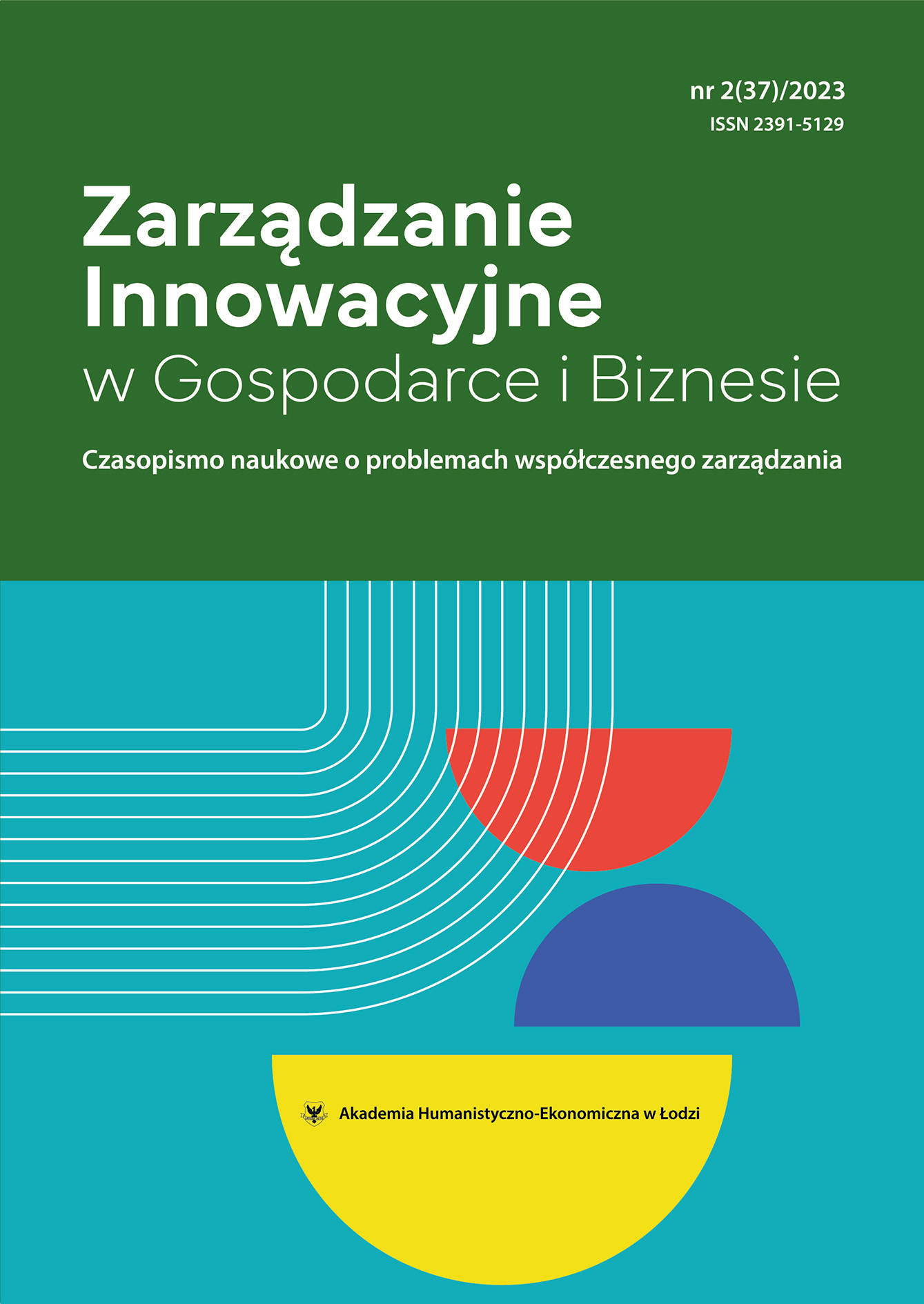The impact of technological innovation on employee retention in enterprises: a case study of quality control
DOI:
https://doi.org/10.25312/2391-5129.37/2023_05KSGKKeywords:
technological innovation, automation, employee retention, reducing monotony, job satisfaction, quality controlAbstract
This article examines the impact of technological innovations on employee retention in the manufacturing sectors, focusing on a case study of quality control. It considers how technology, by reducing the monotony of manual labor and increasing efficiency, can enhance employee experiences. The authors explore the application of innovative technology in the context of quality control, highlighting the challenges associated with its implementation, such as safety, costs, and the need for employee training. The article emphasizes how the proper use of technology can lead to increased job satisfaction, reduced employee turnover, and improved productivity, by presenting the case of a company that has successfully implemented technologies into its quality control processes. The authors note that the effective implementation of technological innovations requires a strategic approach that considers both technological and human aspects.
Downloads
References
Antony J. (2007), Six Sigma: A Strategy for Supporting Innovation in Pursuit of Business Excellence, “International Journal of Technology Management”, no. 37.
Bartecki K., Król D., Skowroński J. (2018), Wyznaczanie kluczowych wskaźników wydajności procesu produkcyjnego – część I: Badania teoretyczne, “Pomiary. Automatyka. Robotyka”, no. 3, pp. 19–28.
Bijańska J., Wodarski K. (2020), Metody zarządzania a kształtowanie zaangażowania pracowników we współczesnych organizacjach. Teoria i praktyka, Dom Organizatora, Toruń.
Brady J.E., Allen T.T. (2006), Six Sigma Literature: A Review and Agenda for Future Research, “Quality and Reliability Engineering International”, no. 22, pp. 335–367.
Brynjolfsson, E., McAfee A. (2014), The Second Machine Age: Work, Progress, and Prosperity in a Time of Brilliant Technologies, W.W. Norton & Company, https://edisciplinas.usp.br/pluginfile.php/4312922/mod_resource/content/2/Erik%20-%20The%20Second%20Machine%20Age.pdf [access: 9.01.2024].
Cappelli P., Keller J.R. (2013), A Study of the Extent and Potential Causes of Alternative Employment Arrangements, “ILR Review”, no. 66(4), pp. 874–901.
Crovini C., Santoro G., Ossola G. (2021), Rethinking Risk Management in Entrepreneurial SMEs: Towards Integration with the Decision-Making Process, “Management Decision”, no. 58, pp. 1086–1087.
Eckes G. (2010), Rewolucja Six Sigma – jak General Electric i inne przedsiębiorstwa zmieniły proces w zyski, MT Biznes, Warszawa.
Evans J.R., Lindsay W.M. (2005), The Management and Control of Quality, South-Western Cengage Learning, Mason.
Gołębiowski M. (2011), DMAIC i DMADV jako metody doskonalenia jakości, Studia i “Prace Wydziału Nauk Ekonomicznych i Zarządzania”, no. 21, pp. 135–141.
Grabowska S. (2017), Kluczowe wskaźniki efektywności – studium przypadku, “Zeszyty Naukowe Politechniki Śląskiej. Organizacja i Zarządzanie”, no. 108, pp. 106–107.
Grycuk A. (2010), Kluczowe wskaźniki efektywności (KPI) jako narzędzie doskonalenia efektywności operacyjnej firm produkcyjnych zorientowanych na lean, “Przegląd Organizacji”, no. 2, pp. 28–31.
Hackman J.R., Oldham G.R. (1980), Work Redesign, Addison-Wesley, Boston.
https://assets.kpmg.com/content/dam/kpmg/au/pdf/2023/australian-business-leader-challenges-2023.pdf [access: 9.01.2024].
ISO 2808 Determination of Film Thickness (2019), https://www.iso.org/standard/71583.html [access: 9.01.2024].
ISO Standard 2808:2019(en) Paints and Varnishes — Determination of Film Thickness (2019), https://www.iso.org/obp/ui/en/#iso:std:iso:2808:ed-5:v1:en [access: 9.01.2024].
KPMG Report (2023), Keeping Us Up at Night, The Big Issues Facing Business Leaders in 2023,
Kraśnicka T. (2018), Innowacje w zarządzaniu, C.H. Beck Publishing, Warszawa.
Nam D., Lee J., Lee H. (2019), Business Analytics Adoption Process: An Innovation Diffusion Perspective, “International Journal of Information Management”, no. 49, pp. 413–422.
Oczkowska R. (2019), Zarządzanie zasobami ludzkimi organizacji – geneza i rozwój koncepcji, [in:] Oczkowska R. (ed.), Zarządzanie zasobami ludzkimi. Uwarunkowania. Instrumenty. Trendy, Warszawa, pp. 13–34.
Parmenter D. (2010), Key Performance Indicators: Developing, Implementing and Using Winning KPIs, Wiley & Sons Inc., New Jersey.
Parmenter D. (2015), Kluczowe wskaźniki efektywności (KPI). Tworzenie, wdrażanie i stosowanie, Helion, Gliwice, pp. 37–38.
Sikora J., Uziębło A. (2013), Innowacja w przedsiębiorstwie – próba zdefiniowania, “Zarządzanie i Finanse”, no. 11(2), pp. 351–363.
Stańczyk E. (2000), Zarządzanie przez grupy autonomiczne, [in:] Perechuda K. (ed.), Zarządzanie przedsiębiorstwem przyszłości. Koncepcje, modele, metody, Agencja Wydawnicza Placet, Wrocław, pp. 220–225.
Stankiewicz J. (2006), Komunikowanie się w organizacji, Astrum, Wrocław.
Sun H., Zhang, P. (2006), The Role of Moderating Factors in User Technology Acceptance, “International Journal of Human-Computer Studies”, no. 64, pp. 53–78.
Tene O., Polonetsky J. (2012), Privacy in the Age of Big Data: A Time for Big Decisions, “Stanford Law Review Online”, no. 63, pp. 63–69.
Ustawa z dnia 10 maja 2018 r. o ochronie danych osobowych, Dz.U. 2018, poz. 1000, https://isap.sejm.gov.pl/isap.nsf/download.xsp/WDU20180001000/U/D20181000Lj.pdf [access: 9.01.2024].
Wesson M.J., Gogus C.I. (2005), Shaking Hands with a Computer: An Examination of Two Methods of Newcomer Orientation, “Journal of Applied Psychology”, no. 90, pp. 1018–1026.
Downloads
Published
Issue
Section
License
Copyright (c) 2024 Akademia Humanistyczno-Ekonomiczna w Łodzi

This work is licensed under a Creative Commons Attribution-ShareAlike 4.0 International License.

